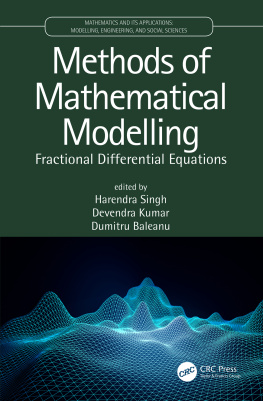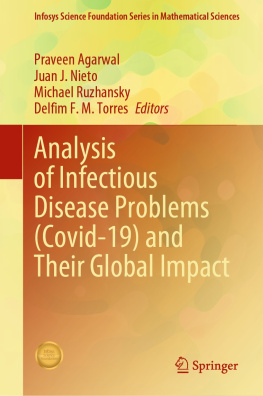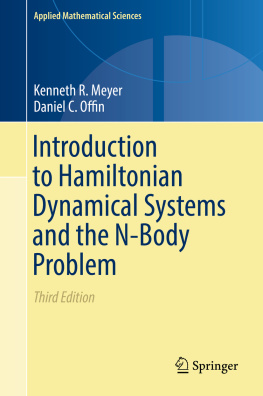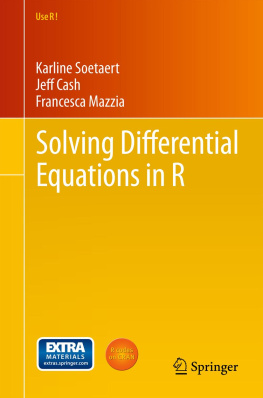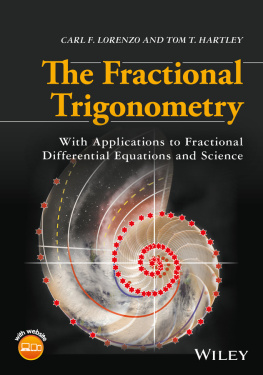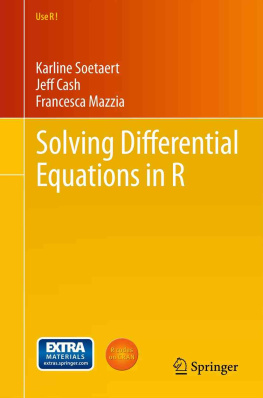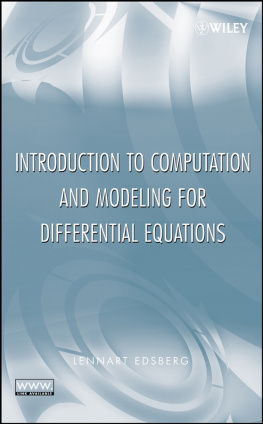Contents
Landmarks
Edited by Harendra Singh, Devendra Kumar and Dumitru Baleanu
Methods of Mathematical Modelling
Mathematics and Its Applications: Modelling, Engineering, and Social Sciences
Series Editor: Hemen Dutta
Department of Mathematics, Gauhati University
Tensor Calculus and Applications:
Simplifled Tools and Techniques
Bhaben Kalita
Concise Introduction to Logic and Set Theory
Iqbal H. Jebril and Hemen Dutta
Discrete Mathematical Structures:
A Succinct Foundation
Beri Venkatachalapathy Senthil Kumar and Hemen Dutta
Methods of Mathematical Modelling:
Fractional Differential Equations
Edited by Harendra Singh, Devendra Kumar, and Dumitru Baleanu
For more information about this series, please visit:
https://www.crcpress.com/Mathematics-and-its-applications/book-series/MES
Edited by Harendra Singh, Devendra Kumar and Dumitru Baleanu
Methods of Mathematical Modelling
Fractional Differential Equations

MATLAB is a trademark of The MathWorks, Inc. and is used with permission. The MathWorks does not warrant the accuracy of the text or exercises in this book. This books use or discussion of MATLAB software or related products does not constitute endorsement or sponsorship by The MathWorks of a particular pedagogical approach or particular use of the MATLAB software
CRC Press
Taylor & Francis Group
6000 Broken Sound Parkway NW, Suite 300
Boca Raton, FL 33487-2742
2020 by Taylor & Francis Group, LLC
CRC Press is an imprint of Taylor & Francis Group, an Informa business
No claim to original U.S. Government works
Printed on acid-free paper
International Standard Book Number-13: 978-0-3672-2008-2 (Hardback)
This book contains information obtained from authentic and highly regarded sources. Reasonable efforts have been made to publish reliable data and information, but the author and publisher cannot assume responsibility for the validity of all materials or the consequences of their use. The authors and publishers have attempted to trace the copyright holders of all material reproduced in this publication and apologize to copyright holders if permission to publish in this form has not been obtained. If any copyright material has not been acknowledged, please write and let us know so we may rectify in any future reprint.
Except as permitted under U.S. Copyright Law, no part of this book may be reprinted, reproduced, transmitted, or utilized in any form by any electronic, mechanical, or other means, now known or hereafter invented, including photocopying, microfilming, and recording, or in any information storage or retrieval system, without written permission from the publishers.
For permission to photocopy or use material electronically from this work, please access www.copyright.com (http://www.copyright.com/) or contact the Copyright Clearance Center, Inc. (CCC), 222 Rosewood Drive, Danvers, MA 01923, 978-750-8400. CCC is a not-for-profit organization that provides licenses and registration for a variety of users. For organizations that have been granted a photocopy license by the CCC, a separate system of payment has been arranged.
Trademark Notice: Product or corporate names may be trademarks or registered trademarks, and are used only for identification and explanation without intent to infringe.
Library of Congress Cataloging-in-Publication Data
Names: Singh, Harendra, editor. | Kumar, Devendra, editor. | Baleanu, D. (Dumitru), editor.
Title: Methods of mathematical modelling : fractional differential equations / edited by Harendra Singh, Devendra Kumar, and Dumitru Baleanu. Other titles: Methods of mathematical modelling (CRC Press)
Description: Boca Raton, FL : CRC Press/Taylor & Francis Group, 2019. | Summary: Mathematical modelling is a process which converts real-life problems into mathematical problems whose solutions make it easy to understand the real-life problem. Fractional modeling has many real-life applications in mathematics, science, and engineering. Such as viscoelasticity, chemical engineering, signal processing, bioengineering, control theory, and fluid mechanics. This book offers a collection of chapters on classical and modern dynamical systems modelled by fractional differential equations. This book will be useful to readers in increasing their knowledge in this field Provided by publisher. Identifiers: LCCN 2019020280 | ISBN 9780367220082 (hardback : acid-free paper) | ISBN 9780429274114 (ebook)
Subjects: LCSH: Mathematical models. | Fractional differential equations.
Classification: LCC TA342 .M43 2019 | DDC 515/.35dc23
LC record available at https://lccn.loc.gov/2019020280
Visit the Taylor & Francis Web site at
http://www.taylorandfrancis.com
and the CRC Press Web site at
http://www.crcpress.com
This book is planned for graduate students and researchers working in the area of mathematical modelling and fractional calculus. It describes several useful topics in mathematical modelling having real-life applications in chaos, physics, fluid mechanics and chemistry. The book consists of thirteen chapters and is organized as follows:
presents the dynamical behaviour of two ecosystems of three species consisting of prey, intermediate predator and top-predator that are still of current and recurring interests. The classical integer-order derivatives in such models are replaced with the AtanganaBaleanu fractional derivative in the sense of Caputo. Existence and uniqueness of solution are established. Linear stability analysis is examined in a view to guide the correct choice of parameters when numerically simulating the models. In the analysis, the condition for a dynamic system to be locally asymptotically stable is provided. A range of chaotic and spatiotemporal phenomena are obtained for different instances of [epsilon1] (0, 1) and are also given to justify the theoretical findings.
investigates the solutions for fractional diffusion equations subjected to reactive boundary conditions. For this, the system is defined in a semi-infinity medium, and the presence of a surface that may adsorb, desorb and/or absorb particles from the bulk is considered. The particles absorbed from the bulk by the surface may promote, by a reaction process, the formation of other particles. The particle dynamics is governed by generalized diffusion equations in the bulk and by kinetic equations on the surface; consequently, memory effects are taken into account in order to enable an anomalous diffusion approach and, consequently, non-Debye relaxations. The results exhibit a rich variety of behaviour for the particles, depending on the choice of characteristic times present in the boundary conditions or the fractional index present in modelling equations.
presents an efficient computational method for the approximate solution of the non-linear fractional Lienard equation (FLE), which describes the oscillating circuit. The Lienard equation is a generalization of the spring-mass system equation. The fractional derivative is in a LiouvilleCaputo sense. The computational method is a combination of collocation method and operational matrix method for Legendre scaling functions. Behaviour of solutions for different fractional order is shown through figures.

